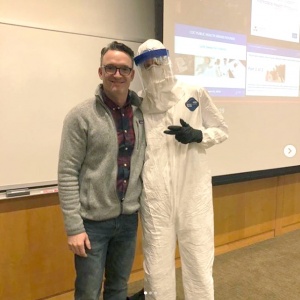
A bubble machine, Instagram, and movies about deadly outbreaks aren’t typical classroom tools, but they’re all part of an innovative course offered at the University of Iowa College of Public Health. The course, “Finding Patient Zero: The Exploration of Infectious Disease Transmission and Pandemic Threats” introduces undergraduate students to public health and core concepts of how infectious disease is transmitted and how transmission can be prevented.
“We talk about fictional movies like Outbreak and Contagion in depth, then shift the focus to real diseases and pandemics,” says course instructor Matt Nonnenmann, an associate professor in the Department of Occupational and Environmental Health.
Nonnenmann discusses infectious diseases caused by viruses, bacteria, and prions (infectious proteins). Students learn how diseases are spread, which populations are most at risk, and what measures can be taken to prevent infections. Much of the learning is interactive and hands-on.
For one assignment, Nonnenmann has students contribute photos to a class Instagram account with the hashtag #UIFPO. Students photograph objects they encounter that potentially could transmit disease. The pictures include a rowing machine at the gym, restroom stall doors, and a public computer.
Another exercise involves demonstrating the Centers for Disease Control and Prevention’s complex procedure for putting on and taking off personal protective equipment used by health care workers caring for an Ebola patient.
“It’s a really long, arduous process,” he says about the full-body protective suit.
And then there are the bubbles.
“I use high-volume bubble machines to demonstrate how potentially infectious bioaerosols can move in a classroom and outdoors,” Nonnenmann says. “Students count the number of bubbles that they come into contact with compared to their proximity to the bubble machine. This activity offers lots of opportunities for scientific observation and discussion about airborne transmission of disease.”
Nonnenmann’s ideas for the class, which is offered every fall semester, are sparked by his own work.
“It’s a blend of the exposure science fields that I work in—microbiology and public health,” says Nonnenmann, who earned a doctoral degree in industrial hygiene from the UI. “My area of research is the measurement, characterization, and control of aerosols that contain biological organisms.”
The range of class activities give students a taste of public health careers and research.
“Students really like the idea of field work,” he says. “We discuss examples of successes like the University of Iowa researchers in the 1950s and 1990s who were ultimately able to discover the genetic sequence of the 1918 Spanish flu by isolating the virus from the bodies of Alaskan natives buried in permafrost. When you have an idea, do research, and then find something, it’s exciting. The hands-on activities were the favorite parts of the class for most students. A lot of the students told me ‘Thank you, I really enjoyed the class and I learned a lot.’ It makes me excited to teach it and I have a lot of fun.”
